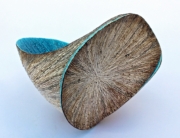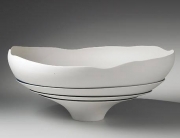Macro crystallization in ceramic art is an interesting topic. It’s a field of study that many artists are still engaged in to this day. While glazing chemistries might be stable there is still a great deal we don’t know about crystalline patterns.
For a long time, it was believed that an oxidation atmosphere was necessary for growing crystals. However, there are now methods of using reduction chemistry to create crystalline glazes. Modern artists are starting to do what previous ones couldn’t.
This isn’t a technology shift so much as it’s a result of the relentless pursuit of new art forms. As artists study older techniques they’re adding on their own innovations. Nevertheless some macro crystallization techniques are quite old.

This Small Tea Bowl is Covered with a Lovely Blue Macro Crystallization Matrix
Growing crystals requires excellent temperature control. When people figured out how to carefully stoke fires they were able to grow interesting crystal patterns. Developing decent glues helped out as well. Mixing kaolin with alumina or even plain water makes a serviceable ceramic paste. Cobalt carbonate, maganese dioxide, red iron oxide, rutile and nickel oxide have all been used in regular crystalline cone ten glazes.
Years after these techniques were developed the scientific study of fractals became extremely popular. Fractals are geometric patterns that are repeated between different levels of magnification. They show similarities on every level and can’t be represented by regular geometric shapes. Many of the effects of these crystalline glazes are similar to what mathematicians would call fractals.
It’s amazing that these patterns were developed organically without any formal scientific study. They weren’t made on purpose. Yakimono artists experimenting with the field of macro crystallization in ceramic art were essentially discovering patterns that naturally exist.
That’s not to say that the only worthwhile studies of these techniques are cold and scientific ones. Artists are experimenting with new designs every day. True macro crystals have come about as a result of electronic kilns. Newer units have thermostats that allow artists to adjust the temperature directly.

Artwork Produced with Macro Crystallization Techniques Sometimes takes on a Floral Pattern
Some people still elect to grow crystals in fueled ovens. Gas kilns were preferred before electric kilns came around. This provided the aforementioned neutral-to-oxidizing atmosphere needed to grow crystals the old fashioned way. Specific firing schedules allow potters to introduce reduction in the final stages.
Oxidation atmosphere conditions are still normally required to grow crystals. Skilled potters introduce chemical reduction as the glaze starts to really take hold of the ceramic base. Art students who visit a modern ceramics exhibit at a museum will surely notice the strange patterns created as a result of this process.




